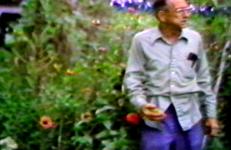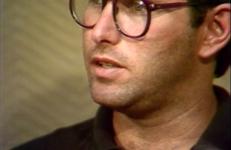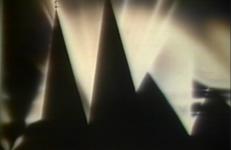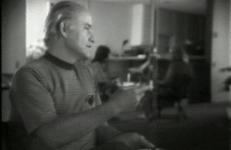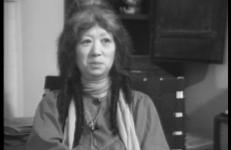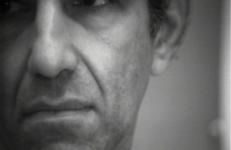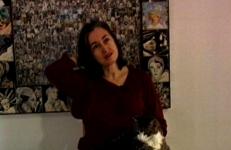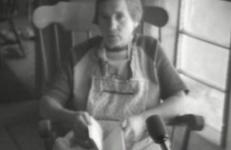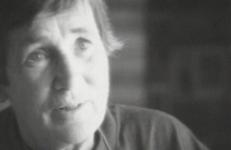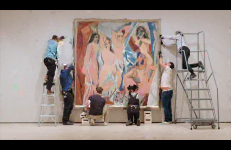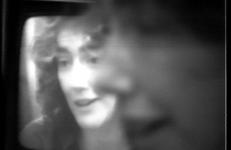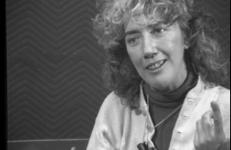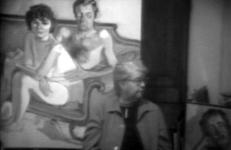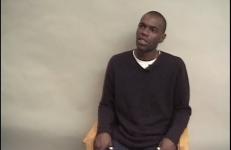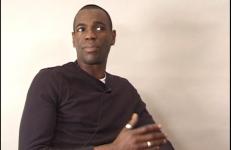The Duet Project: Distance is Malleable is a mutable and evolving series of experiments in collaboration. Negotiating differences of race, time, culture, ethnicity, religion and gender, the artists seek to maximize the potentials of their encounters.
Painting
Eiko's grandfather Chikuha Otake (1878–1936) was a praised figure in traditional Japanese painting. But his anti-mainstream sentiments were shunned by the field authorities. His reputation was severely damaged by his failed run for the House of Representatives. Filmed in 2018, at the Philadelphia Museum of Art and the Suiboku Museum in Toyama, Japan, Eiko's edit combines videos of Chikuha's paintings and Eiko's performance with quotes from his essays and Eiko's musings.
Special thank you to David Brick, Ryohei Endo, Hiroyuku Horikawa, Feliece Fischer, and John Killacky.
The fourth collaboration between Jessie Mott and Steve Reinke continues its melancholic musings on desire and mourning, this time with more twerking. Hypnotic backgrounds and eccentric animals lend to its psychedelic children's cartoon vibe, and the signature Madonna and Stockhausen soundtrack enhances the desperation for paradise among those extra long tongues and snake-y bodies.
The fourth collaboration between Jessie Mott and Steve Reinke continues its melancholic musings on desire and mourning, this time with more twerking. Hypnotic backgrounds and eccentric animals lend to its psychedelic children's cartoon vibe, and the signature Madonna and Stockhausen soundtrack enhances the desperation for paradise among those extra long tongues and snake-y bodies.
The temperature in your eyes will rise when you contract ‘FEVER DREAMS’ and experience the haunted mayhem contained therein.
This title comprises The Stone Boy (2011), Nonsensical (2014), and Coffee, Tea, and Wizardry (2015) which were compiled into this form by Mike Kuchar in 2022.
Reverend Howard Finster was a preacher-turned-folk artist. He created Paradise Gardens Park & Museum, a product of all his murals, drawings, sculptures, and mosaics—and Summerville, Georgia’s largest tourist attraction. He began Paradise Gardens around 1961; in 1976 he responded to a vision to paint sacred art. As this video begins, Finster is painting with his hands in his studio. Finster then embarks on his first visit to New York City and comments upon his exhibition at Phyllis Kind Gallery. He spins rhythmic narratives that turn into miniature sermons.
Eric Fischl's early works were large-scale abstract paintings. While teaching in Nova Scotia, Fischl began to shift from abstraction to smaller, image-oriented paintings, beginning with narrative works that investigated a fisherman's family. By the time Fischl left Halifax the narrative element was gone, but the subject of family melodrama remained. In the '80s Fischl's large figurative paintings, aggressive in their confrontation with the viewer, began to receive attention.
Painter and multi-media artist Jack Goldstein lived and worked in New York City. His airbrushed paintings of lightning and night skies are shown here accompanied by synthetic music, which the artist also composed. Goldstein committed suicide in 2003.
Interviewed by Jim Johnson.
Nancy Graves (1939-1995) was a New York sculptor, painter, and filmmaker who used natural history as a reference for dealing with the relationships between time, space, and form.
In this interview she discusses her transition from a static form (sculpture) to a moving form (film), and finally, to painting. “The making of it and the viewing of it are the areas with which I’m most concerned, because I’m an artist, not a philosopher,” Graves says in this interview with Kate Horsfield.
Douglas Hollis (b.1948) was born in Ann Arbor, Michigan and continued to live there throughout the years of his college education at the University of Michigan. From an early age he had a deep interest in Native American culture. His experiences traveling in Oklahoma to live with Indian families has strongly influenced his life and his art ever since. Hollis began working with natural phenomena and responsive environment structures in the later part of the 1960's. At that time he completed several projects with musicians, dancers, film makers, engineers, and physicists.
Taped shortly after the creation of the Air Gallery, this conversation between painter Howardena Pindell and Hermine Freed concerns the women’s independent gallery and its role in the feminist movement. Pindell also discusses the development of her work and the relation between black artists and the art world.
Robert Irwin (b. 1928, Long Beach, California) followed in the Abstract Expressionist tradition until he shifted his focus onto installation projects that play upon site-specific uses of light. Since the 1980s, he has created large-scale public space designs that use natural light, plants, and garden architecture.
Miyoko Ito was known as an “abstract surrealist.” Her paintings are landscape-based abstractions of very intense subtleties of structure and color. Ito was born to Japanese parents in Berkeley, CA in 1918. She studied art at the University of California at Berkeley for a short time until she was imprisoned in a Japanese-American camp after the bombing of Pearl Harbor. Ito continued her education in prison, after which she attended Smith College. She was then given a scholarship to attend the School of the Art Institute of Chicago. It was in Chicago that Ito's career as an artist flourished, where she explored cubism and latent abstraction in her works. Ito remained in Chicago until her death in 1983.
American figurative artist Alex Katz (b.1927) has produced a remarkable and impressive body of work but is best known for his large-scale, flat, yet realistic portraits of friends and family notable for their relaxed attitudes and uncomplicated bearing. In the early 1960s, influenced by films, television, and billboard advertising, Katz began painting large-scale paintings, often with dramatically cropped faces.Utilizing characteristically wide brushstrokes, large swathes of color, and refined compositions, Katz created what art historian Robert Storr called "a new and distinctive type
Joyce Kozloff was at the forefront of the 1970s pattern and decoration movement—a feminist effort to incorporate typically “feminine” and popular decorative arts into the fine arts. She has been involved with public art and murals for more than two decades. In this video, Kozloff prepares and installs her mural Around the World on the 44th Parallel, which features sections of maps from 12 cities around the world on the same latitude. The work was constructed at the Tile Guild in Los Angeles and installed at the library at Minnesota State University-Mankato.
At nineteen, Barbara Kruger (b. 1945) worked as a commercial artist designing for Conde Nast. The risky combination of contemporary art, commercial appeal and social critique runs throughout Kruger’s photography, readings, poetry, collages, and conversation. Her works uses advertising both as a foil and a format. Language and image work together, referencing the manipulations of the advertising media.
Originally from Canada, Agnes Martin (1912-2004) moved to the U.S. in 1931. Martin lived in Taos, New Mexico from 1954 to 1957, and then moved to New York, where she established her name as an important minimalist painter.
Originally from Canada, Agnes Martin (1912-2004) moved to the U.S. in 1931. Martin lived in Taos, New Mexico from 1954 to 1957 and then moved to New York, where she established her name as an important minimalist painter. Her work differed conceptually from the minimalist movement in that it was anti-intellectual and intensely spiritual, and her grids represented meditative reflections on Taoism.
Joan Mitchell (1925-1992) was a "second generation" abstract expressionist painter and printmaker. She was an essential member of the American Abstract expressionist movement, and one of the few female painters to gain critical and public acclaim in the era.
A brief glimpse of a confessional detour during a pictorial drift.
Elizabeth Murray (1940-2007) was an American painter, printmaker and draughtsman. She studied at the Art Institute of Chicago (1958–62) and at Mills College, Oakland, CA (1962–4). Elizabeth Murray’s paintings have been referred to as “dandyish abstraction.” Her work is distinctive in its use of color, shape, and surface to evoke human characteristics, personalities or humor.
Elizabeth Murray (1940-2007) was an American painter, printmaker and draughtsman. She studied at the Art Institute of Chicago (1958–62) and at Mills College, Oakland, CA (1962–4). Elizabeth Murray’s paintings have been referred to as “dandyish abstraction.” Her work is distinctive in its use of color, shape, and surface to evoke human characteristics, personalities or humor. Murray is particularly well known for her shaped canvases, which date from 1976, on to which are painted both figurative and non-figurative elements.
Alice Neel (1900-1984) is known for portrait paintings of well-known persons and eccentric New York street types. Neel worked as a figurative painter throughout the decades of WPA realism, postwar abstract expressionism, 1960s Pop, and 1970s minimalism. She persevered in her work despite a turbulent personal life and critical neglect that continued until the 1960s. Neel lived and worked in New York City from 1932 until her death in 1984.
In this 2004 interview, Kori Newkirk (b.1970) describes his lifelong apprehension of being rooted in any one place for too long. Asserting that the School of the Art Institute of Chicago was the fifth school he attended in four years, Newkirk begins by describing the fortuitousness of his relocation to Chicago following his expulsion from Cooper Union. Recounting how he fled from the fiber department in favor of painting, Newkirk details how it was a studio visit from Deborah Kass and an exchange program to England that crystallized his burgeoning ideas about “painting without making paintings.”
In this interview, Kori Newkirk (b.1970) describes his interest in the space that exists between categories. Hailing from the Bronx, earning a BFA at the School of the Art Institute of Chicago (SAIC), and finally settling on Los Angeles as his base of operations, Newkirk has always been motivated by a desire to eschew provincialism. In this conversation, he discusses the idea of regional identity, his complex relationship with the Los Angeles art community, and how his experience as a student at SAIC helped him move beyond the boundaries of a simple material definition of painting.








